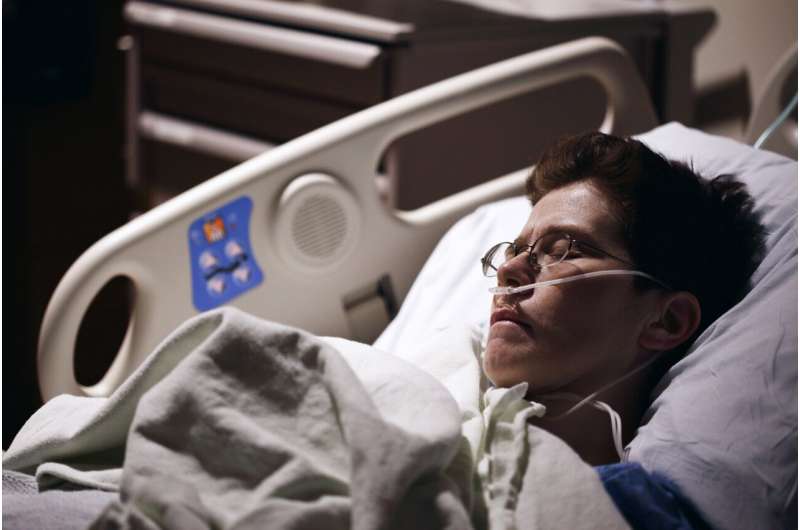This article has been reviewed according to Science X's editorial process and policies. Editors have highlighted the following attributes while ensuring the content's credibility:
fact-checked
proofread
Understanding survival factors in critically ill patients on extracorporeal membrane oxygenation

Extracorporeal membrane oxygenation (ECMO) is a widely used advanced life support procedure that provides cardiac and respiratory support to critically ill patients. ECMO use has been increasing exponentially over the last decade as it has shown success in resuscitating patients in critical situations like the COVID-19 pandemic and is now a lifesaving treatment modality in intensive care units (ICUs). However, prolonged ECMO use may be associated with an increased risk of mortality.
Identifying risk factors for in-hospital mortality and developing standardized nursing practice guidelines for ECMO management may improve the survival rates in patients.
In this vein, a group of researchers led by Professor Youn-Jung Son from Chung-Ang University, South Korea, set out to study the prevalence and risk factors associated with the 30-day in-hospital mortality in critically ill adult Korean patients on ECMO. This paper was published in Intensive and Critical Care Nursing.
"In-hospital mortality due to ECMO support, regardless of its type, has not been well reported in Korea. Thus, it is crucial to provide training to various stakeholders in Korea (e.g., ICU nurses) to enhance collaboration, particularly for the optimal ECMO management to reduce in-hospital mortality or improve the survival rate post- hospital discharge," explains Prof. Son.
They conducted a retrospective cohort study in a single tertiary-care university hospital between May 2020 and April 2021. Patients were screened using their electronic medical records, and 148 patients aged 18 years or above, who received ECMO support for at least 48 hours, were included in the study.
Based on their 30-day in-hospital survival status following ECMO initiation, the researchers categorized the patients as survivors and non-survivors. Various pre-ECMO and post-ECMO (up to 30 days from the day of initiation) parameters were collected and compared.
The 30-day mortality rate is used to measure performance in clinical settings. In the current study, the researchers found the 30-day in-hospital mortality rate to be 49.3%, with heart and multi-organ failures identified as the most common causes of death. Furthermore, the average duration of ECMO support was approximately 11 days, and the in-hospital median survival was 13 days. This finding emphasizes the importance of early detection of risk factors for mortality to improve patient outcomes.
Further investigations found significant differences in various pre-ECMO and post-ECMO parameters between survivors and non-survivors. Statistical analyses revealed that ECMO weaning failure, new-onset renal failure, and a lower average mean arterial pressure (MAP) of <65 mmHg post-ECMO were associated with an increased risk of 30-day in-hospital mortality rate. Among these factors, ECMO weaning failure was identified as the strongest predictor of death in patients requiring ECMO.
Interestingly, this is the first retrospective cohort study to investigate the prevalence and risk factors associated with 30-day in-hospital mortality in a Korean sample. The current study reveals that vigilant monitoring of post-ECMO renal function and average MAP is the key to minimize the death rate, especially within the first two weeks of ECMO initiation. Additionally, the ECMO team must work together and cooperate for successful ECMO weaning for higher survival rates.
Patients on ECMO are usually cared for by ECMO specialist nurses or ICU nurses, who hold certifications in this area. However, in Korea, ICU nurses are the primary medical staff caring for ECMO patients, yet there are no specific training modules or qualification exams for this role. This study highlights the role of ICU nurses in reducing ECMO mortality rates and provides significant evidence-based framework for development of nursing practice guidelines.
Elaborating on the long-term impacts of their study, Prof. Youn-Jung concludes, "The results of our study provide sufficient evidence for developing standardized nursing practice guidelines that may provide patients with appropriate care at each point in their ECMO journey, thereby improving patient safety and reducing hospital mortality in critically ill adults on ECMO."
Furthermore, these findings could be the foundation for development of multifaceted interventions that can contribute to the improvement of health-related quality of life in patients discharged from ECMO. Finally, by reducing adverse events in patients on ECMO, unnecessary health care expenditures for individuals and various countries can be reduced.
More information: Youngeon Lee et al, Factors associated with 30-day in-hospital mortality in critically ill adult patients receiving extracorporeal membrane oxygenation: A retrospective cohort study, Intensive and Critical Care Nursing (2023). DOI: 10.1016/j.iccn.2023.103489





















